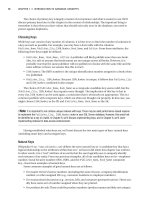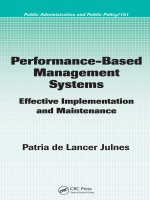Relational Database Management Systems, Database Design, and GIS pptx
Bạn đang xem bản rút gọn của tài liệu. Xem và tải ngay bản đầy đủ của tài liệu tại đây (679.31 KB, 112 trang )
presented by:
Tim Haithcoat
University of Missouri
Columbia
With materials from:
Peter Veenstra
M.J. Harden Associates
Relational Database
Management Systems,
Database Design, and
GIS
Overview of GIS Database Design
• A geographic information system (GIS) is
comprised of several elements, including
• Hardware
• Software
• Users/People
• Procedures/Methods
• Data
• GIS Organizations…
• Select hardware and software
• Train their users
• Develop procedures
• The technology incorporated into business flow• Comprised of two systems - one to handle the spatial
elements, another to manage attribute data
• Most hybrid systems use a proprietary data model
• Separate storage systems complicate database maintenance,
increase disk access and network traffic
• Requires diligence, attention to detail and special
applications to maintain feature-attribute linking.
• What happens when a user splits a line segment?
• Where does the original attribute records go?
• How do you maintain a historical record of line splitting?
• How are other GIS layers affected by splitting a pipe?
• Example of a Hybrid Model? (ARC/INFO, ESRI ShapeFile)
• Overview of GIS Database Design
• Continuous, non-tiled, spatial database for adding
spatial data to a relational database management
system (RDBMS).
• Database interface that couples spatial data to the
RDBMS allowing for high-performance access to all
the data in there, spatial and non-spatial.
• No more split system data management-single source
editing. Requires special maintenance application to
main topology, perform database edits, updates and
maintenance (ArcFM)
• Utilize the inherent strengths of commercial
RDMBS’s
Spatial Server (RDBMS) Hybrid Model
-or- Flat File
User Access Roles, users, built-in security. No inherent security.
Security Stored in Proprietary Files not
accessible from any other application
than the RDBMS.
Disk files, easily recognizable, editable
with external applications.
Data Integrity Enforces referential integrity, data
stamping, user access and rights,
triggers, procedures, transactions
(rollbacks, commits)
No internal enforced referencing (IDEDIT,
RENODE).
Buffered
Throughput
Designed for fast transfer of packets
through network. Only access what
you need.
Access everything within the spatial extent,
accessing both spatial and attribute features
each with their own data structure.
Multi-user Multiple users can access data.
Allows for row or table level locking.
Optimistic and pessimistic updating.
User roles determine editing rights.
Only one user can edit records. No built in
locking or updating mechanisms. No built
in security.
Open Data
Structure
Relational database mechanism is
well known. ORACLE Spatial Data
Option is normalized tables, SDE uses
blobs - but reveals a lot about the data
structure.
ShapeFIles: One feature table, one index
file and one dBase file - published - very
difficult. ARC/INFO totally proprietary.
Robustness Roll-back segments. Redo Logs files,
Back and Recovery tools. Well
established kernel.
Lose or corrupt the file and hope that you
have some back-up.
Data
Restructuring
Views can be created from tables and
can be stored as objects within the
database
One flat file is a flat file. Can create
definitions within ArcView or reselect
statements in ARC/INFO. Not predefined
objects.
records or tuples so that relations between
different entities and attributes can be used for
data access and transformation.
~ Burroughs, 1986
A database structure commonly used in GIS in
which data is stored based on 2 dimensional
tables where multiple relationships between data
elements can be defined and established in an
ad-hoc manner.
~ Croswell, 1991
Relational Database Management System - a
database system made up of files with data
elements in two-dimensional array (rows and
columns). This database management system
has the capability to recombine data elements
to form different relations resulting in a great
flexibility of data usage.
~ after Martin, 1976
• A database that is perceived by
the user as a collection of two-
dimensional tables
• Are manipulated a set at a time,
rather than a record at a time
• SQL is used to manipulate
relational databases
The Relational Database Concept
• Proposed by Dr. Codd in 1970
• The basis for the relational database
management system (RDBMS)
• The relational model contains the
following components:
• Collection of objects or relations
• Set of operations to act on the relations
• Data integrity for accuracy and consistency
(1 of 2)
• Rigorous design methodology (normalization,
set theory)
• All other database structures can be reduced to a set
of relational tables
• Mainframe databases use Network and Hierarchical
methods to store and retrieve data.
• Access to the data is hard-coded
• It is very difficult to extract data from this type of database
without some pre-defined access path.
• Extremely fast retrieval times for multi-user, transactional
environment.
• Ease the use compared to other database systems
(2 of 2)
• Modifiable - new tables and rows can be
added easily
• The relational join mechanism
• Based on algebraic set theory - a set is a group of
common elements where each member has some unique
aspect or attribute
• very flexible and powerful
• Fast Processing
• Faster processors, multi-threaded operating and parallel
servers
• Indexes, fast networks and clustered disk arrays
• 57,000 simultaneous users (Oracle/IBM)
• Expensive solutions that require
thorough planning
• Easy to create badly designed and
inefficient database designs if there is
not any proper data analysis prior to
implementation
DBMS
• A software package for
stage, manipulate and
retrieval of data from a
database
• Serves many users
simultaneously
Kernel
• Core software, controls query
processing, access paths to
data, user access management,
storage management,
indexing, transaction
processing and read/update
information
Query Language Interface
• Wrapped around the kernel,
allows the ad hoc query against
the database
Interactive Query Tool
• Access, edit, and update of
one or more linked data
tables using screen based
forms.
Utilities
• Import/export/backup
tuning tools
• Parameterization/report
writers
Database
• Physical storage of the data
objects within data files
• contains the system
catalogues (data dictionary)
• A collection of one or more
data files stored in a
structural manner
• Relationships which exist
between different sets of
data
Processes (memory)
• Database Writer,
Archiving, User Manager,
Server Manager, Redo
Log files
Design
Business Information Requirements
Conceptual
Data Modeling
Database
Build
Database
Design
Entity-Relationship Data Model
Entity Definitions
Table Definitions
Index, View, Cluster, and
Space Definitions
Strategy
Analysis
Design
Build
STRATEGY
DESIGN
Operational System
Operational System
BUILD
USER
DOCUMENTATION
TRANSITION
PRODUCTION
ANALYSIS
Conceptual
Data Modeling
Database
Build
Database
Design
E-R Data Model
Entity Definitions
Table Definitions
Index, View, Cluster,
and Space
Definitions
Strategy
Analysis
Design
Build
Function
Modeling
Application
Build
Application
Design
Function Hierarchy
Function Definitions
Data Flow Diagrams
Module Designs
Operational
Database
Operational
Application
Operational
System
Cross-Checking
Cross-Checking
Good Database Design Prevents
• Unnecessary or forgotten data
• Inflexibility for database re-sizing or
modification
• Poor data element specification
• Poor database integration between the parts of
the database
• Unsupported applications
• Major database update costs
• Depends on the ability of the system to
provide quality information
• Depends on the quality of usability of the
data that resides on the system
• Ad-hoc approach versus systematic
approach
• Begin with the “end in mind”
• Applications
• Data format and size
• Data maintenance and update
• Hardware/software
• Number and sophistication of users
• Schedule and budget of the project
• Management approach
• Is to maintain…
• Data consistency/integrity
• Reduce data redundancy
• Increase system performance
• Maintain maximum user flexibility
• Create a useable system









